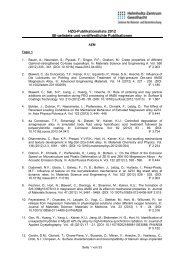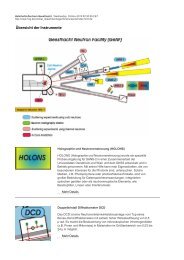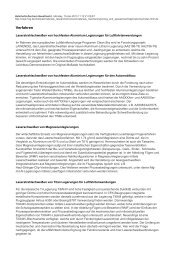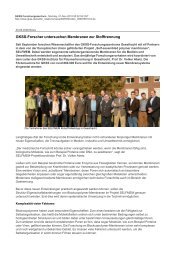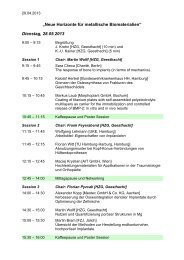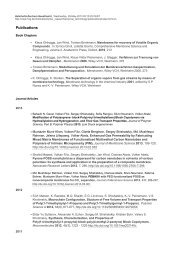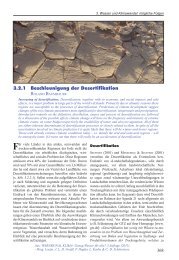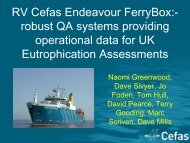High-resolution wave climate analysis in the Helgoland area - GKSS
High-resolution wave climate analysis in the Helgoland area - GKSS
High-resolution wave climate analysis in the Helgoland area - GKSS
You also want an ePaper? Increase the reach of your titles
YUMPU automatically turns print PDFs into web optimized ePapers that Google loves.
Chapter 2<br />
Dynamical <strong>wave</strong> model<strong>in</strong>g<br />
2.1 Methods, data and tools<br />
In this section <strong>the</strong> ma<strong>in</strong> pr<strong>in</strong>ciples and features of <strong>the</strong> spectral <strong>wave</strong> model<strong>in</strong>g are described.<br />
In particular <strong>the</strong> K-model is discussed as <strong>the</strong> ma<strong>in</strong> tool for <strong>the</strong> <strong>wave</strong> simulations.<br />
Subsequently, <strong>the</strong> HIPOCAS project, <strong>the</strong> ma<strong>in</strong> source of <strong>the</strong> external forc<strong>in</strong>g data for <strong>the</strong><br />
K-model experiments, is described. F<strong>in</strong>ally, <strong>the</strong> model doma<strong>in</strong> <strong>in</strong> <strong>the</strong> German Bight is<br />
specified and <strong>the</strong> details of <strong>the</strong> experiment setup are presented.<br />
2.1.1 K-model. Description and features.<br />
Wave models usually describe <strong>the</strong> evolution of a sea state depend<strong>in</strong>g on <strong>in</strong>itial and<br />
boundary conditions as well as external fields like w<strong>in</strong>d, currents and bathymetry. The<br />
sea state is def<strong>in</strong>ed as a number of <strong>wave</strong> tra<strong>in</strong>s with different <strong>wave</strong> lengths and periods<br />
generated at or com<strong>in</strong>g to a specific location at certa<strong>in</strong> time. With<strong>in</strong> this concept two classes<br />
of <strong>wave</strong> models can be dist<strong>in</strong>guished (for recent overview see Ris [1997] or Cardone and<br />
Resio [1998]). So-called ”phase-resolv<strong>in</strong>g models”, characterized by explicitly determ<strong>in</strong>ed<br />
superposition of <strong>wave</strong> tra<strong>in</strong>s consider<strong>in</strong>g <strong>the</strong>ir phases, belong to <strong>the</strong> first group. Such models<br />
are advantageous <strong>in</strong> <strong>the</strong> problems where <strong>the</strong> changes <strong>in</strong> <strong>the</strong> environment occur on <strong>the</strong> scale<br />
of <strong>wave</strong> lengths and periods or where diffraction is important. These models are often used<br />
for specific small <strong>area</strong>s such as harbors or for short-time applications. The second class<br />
conta<strong>in</strong>s ”phase-averag<strong>in</strong>g” or spectral models. In <strong>the</strong>se models <strong>the</strong> <strong>wave</strong> tra<strong>in</strong>s which form<br />
<strong>the</strong> sea state are considered <strong>in</strong>dependently of <strong>the</strong>ir phases. With this approach <strong>the</strong> sea<br />
surface can not be described <strong>in</strong> detail and <strong>the</strong> spatial and time <strong>resolution</strong>s of <strong>the</strong>se models<br />
are supposed to be larger than <strong>the</strong> typical <strong>wave</strong> length and <strong>wave</strong> period. These models<br />
are used for <strong>the</strong> most of medium and large scale applications due to <strong>the</strong> computational<br />
reasons as advantageous with respect to <strong>the</strong> phase-resolv<strong>in</strong>g models. They also allow <strong>the</strong><br />
easier and more accurate consideration of <strong>the</strong> random-phase source functions such as w<strong>in</strong>d<br />
energy <strong>in</strong>put and <strong>wave</strong> dissipation. Fur<strong>the</strong>r <strong>in</strong> this study <strong>the</strong> phase-averag<strong>in</strong>g <strong>wave</strong> models<br />
are considered. The <strong>the</strong>oretical background for this k<strong>in</strong>d of models can be found <strong>in</strong> Komen






